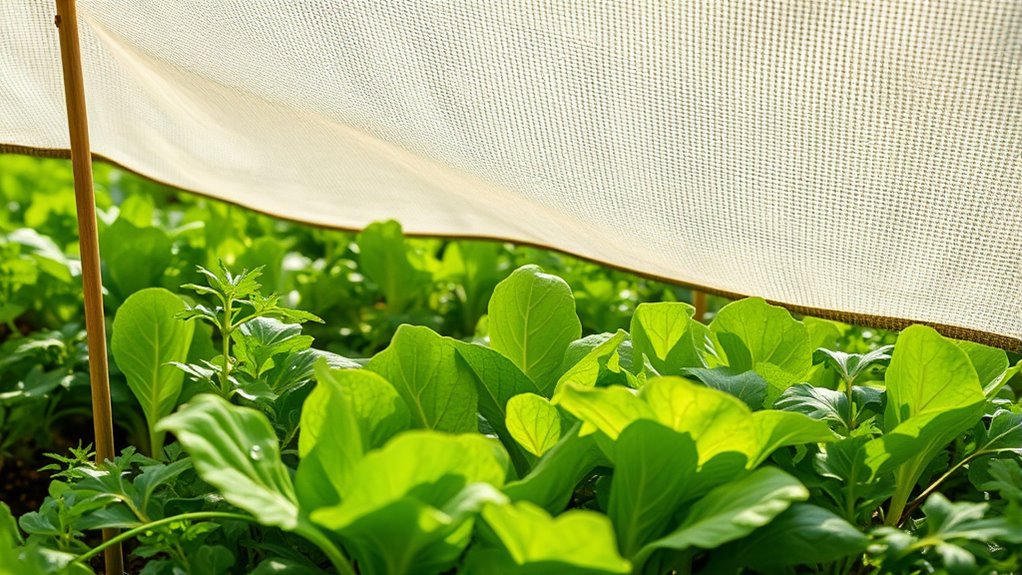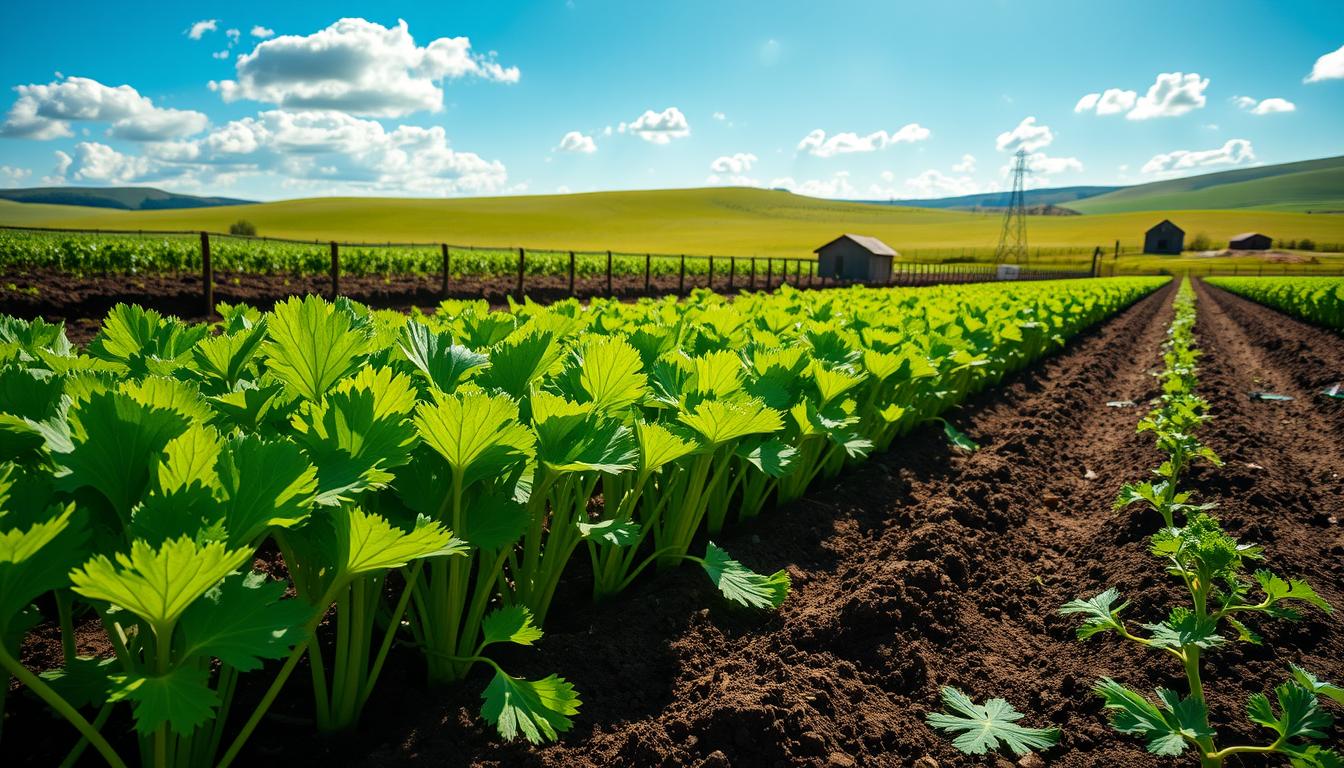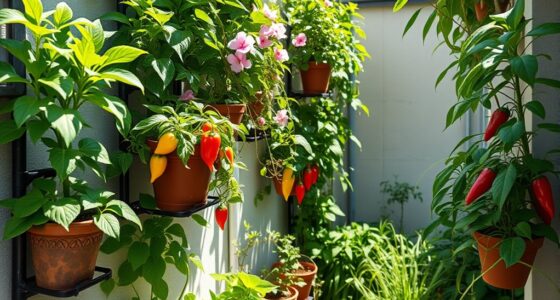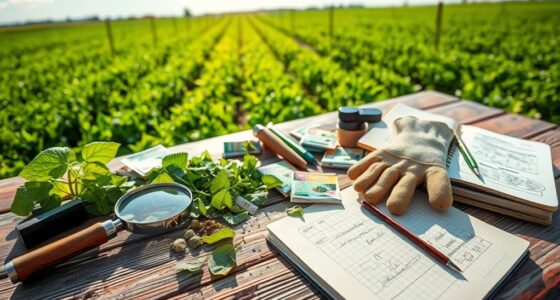Using shade cloth can help you protect salad greens from intense sunlight and heat, preventing premature bolting and dehydration. By choosing a suitable shade percentage—generally 30-50%—and installing it properly, you create a microclimate that keeps greens cooler and healthier. This extension of the harvest window relies on good setup and ongoing adjustments. Keep exploring these tips to maximize growth and keep your greens thriving for longer periods.
Key Takeaways
- Install shade cloth during hot weather to prevent heat stress and bolting, extending the harvest period for salad greens.
- Choose the appropriate shade percentage (30-50%) to protect greens from excessive sunlight while maintaining healthy growth.
- Properly secure and tension the shade cloth to ensure full coverage and prevent gaps that could reduce effectiveness.
- Use UV-resistant, durable fabric to prolong lifespan and safeguard greens from sun damage and pests.
- Regularly monitor and adjust the shade setup based on weather conditions and plant response to maximize growth and harvest extension.
Understanding the Benefits of Shade Cloth for Salad Greens
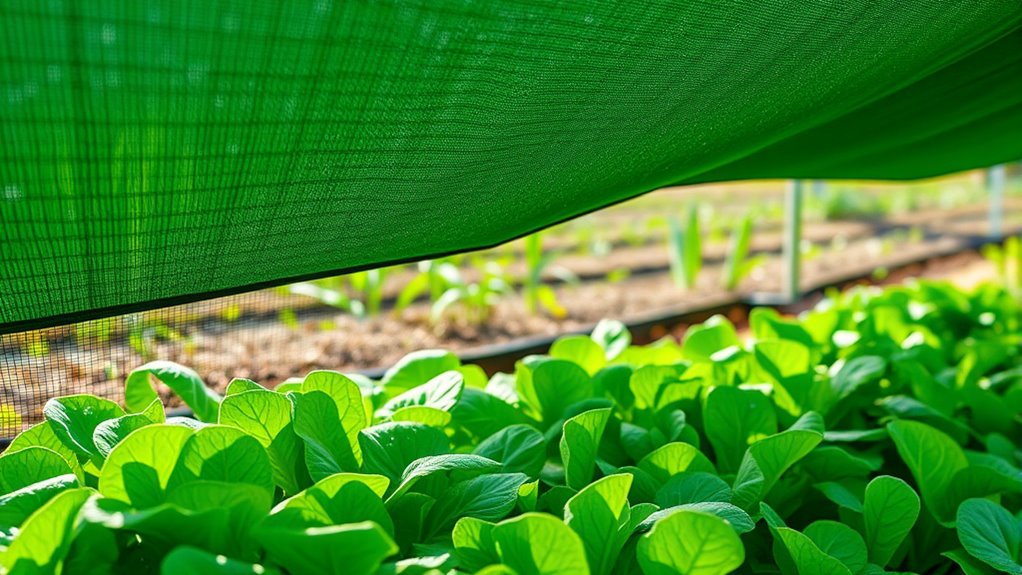
Shade cloth offers a simple yet effective way to protect your salad greens from excessive heat and sunlight. By reducing direct sun exposure, it helps maintain consistent temperatures, preventing your greens from wilting or bolting prematurely. This protection allows you to develop a reliable watering schedule, ensuring your plants receive adequate moisture without overwatering or underwatering. Additionally, shade cloth can serve as a barrier against pests, making it harder for insects to reach your greens and reducing the need for chemical treatments. Incorporating pest management strategies can further enhance your gardening success by controlling unwanted insects more effectively. Properly managing irrigation techniques in conjunction with shade cloth ensures optimal moisture levels and plant health. Using shade cloth can also create a more microclimate around your garden, which can be beneficial for sensitive salad greens. Overall, using shade cloth creates a more stable environment, promoting healthy growth and extending your salad greens’ harvest window. It’s an easy, practical solution that enhances your gardening success while keeping pests at bay. Incorporating outdoor seating options can further improve your gardening experience by providing a comfortable space to enjoy your harvest. Utilizing HVAC technology such as climate control solutions can also help create optimal conditions for plant growth in larger or more complex garden setups.
Choosing the Right Shade Cloth for Your Garden

Selecting the appropriate shade cloth depends on understanding your garden’s specific needs and local climate conditions. You should consider fabric selection carefully, as different materials offer varying durability and light diffusion. Color options also influence heat absorption and light reflection, impacting plant health. Here’s a quick guide to help you choose:
| Fabric Type | Color Options | Benefits |
|---|---|---|
| Polyethylene | Green, black, white | Durable, UV resistant, customizable shading |
| Polyester | Tan, gray | Lightweight, high heat resistance |
| Polypropylene | Blue, tan | Cost-effective, easy to install |
Additionally, considering the UV resistance of the fabric can help extend the lifespan of your shade cloth and protect your salad greens more effectively. Properly selecting a light diffusion level can further optimize plant growth and prevent sun scorch. A well-chosen shade cloth with appropriate air circulation properties can also help reduce humidity and disease development around your greens. Understanding the importance of color options in relation to heat absorption can further enhance plant health and growth. Choosing the right combination ensures your salad greens get ideal light reduction and protection, keeping them healthy and productive longer.
Determining the Optimal Shade Percentage for Leafy Greens
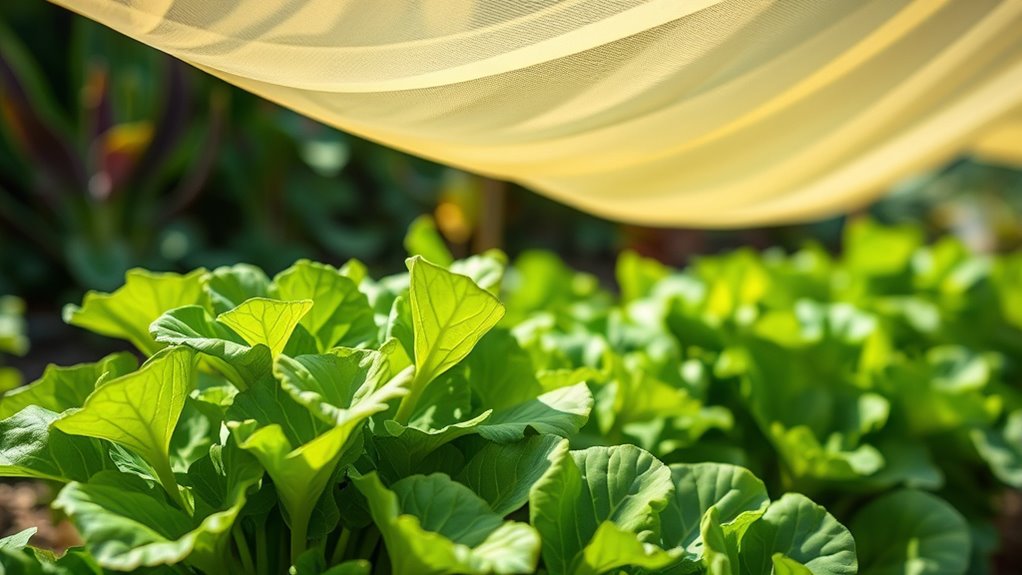
To find the best shade percentage for your leafy greens, you need to control light intensity effectively. Too much shade can weaken plants, while too little can cause stress and wilting. Adjusting the shade guarantees your greens stay healthy and productive without unnecessary stress. Monitoring light exposure levels helps optimize plant growth and prevent potential damage. Recognizing plant stress signs can also guide you in fine-tuning the shade for optimal health. Implementing tuning techniques used in Hyundai vehicles can inspire precise adjustments for your indoor garden environment. Additionally, understanding AI safety measures can assist in developing more reliable and resilient shading systems that adapt to environmental changes. Incorporating advanced control systems can further enhance the accuracy of your shading adjustments, ensuring consistent plant conditions.
Light Intensity Control
Since light intensity directly affects the growth and quality of leafy greens, finding the right amount of shade is essential. Too much sun can cause scorching, while too little can hinder photosynthesis. To optimize shade, consider the ideal percentage that balances UV protection and pest deterrence. A moderate shade cloth (around 30-50%) often provides enough UV protection without limiting growth. This level also helps deter pests that thrive in full sun. Keep in mind that different greens may require adjustments: some may need more shade, others less. Regularly monitor plant health and modify shade accordingly. Proper light control ensures vibrant, tender leaves and reduces stress. Additionally, understanding light management techniques can further enhance plant health. Implementing shade cloth adjustment strategies based on seasonal changes can optimize plant performance throughout the year. Achieving the right shade percentage ultimately promotes healthy, high-quality salad greens. Properly managing light levels is crucial for maximizing yield and quality in leafy greens.
Plant Stress Reduction
Finding the ideal shade percentage is key to minimizing stress on leafy greens and ensuring healthy growth. Proper sunlight management helps prevent leaf scorch and bolsters photosynthesis, while temperature regulation keeps plants cool during hot days. Too much shade can hinder growth by limiting light, but too little can cause heat stress and dehydration. To reduce plant stress, assess your local climate and experiment with different shade levels—usually between 30% and 50%. This balance allows enough sunlight for photosynthesis without overheating the plants. Consistent shade coverage helps maintain stable temperatures, preventing stress-related issues like wilting or slowed growth. By fine-tuning your shade cloth, you create an optimal environment that supports healthy, resilient leafy greens. Additionally, understanding Gold IRA and their benefits can help you explore alternative investment options for your financial growth. Maintaining proper garden organization and regularly adjusting your shade setup can enhance plant health and yield. Adjusting shade levels based on plant stress reduction techniques ensures that your greens stay vigorous and productive.
Proper Installation Techniques for Shade Cloth
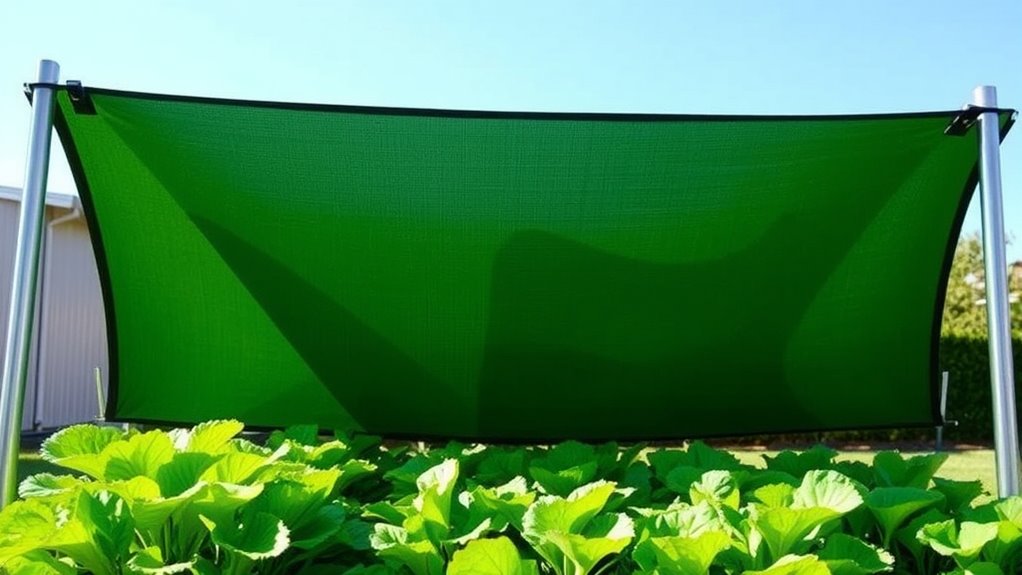
Proper installation of shade cloth is essential to guarantee it effectively protects your salad greens. First, plan your layout carefully, ensuring the cloth covers the desired area without sagging. When attaching, use secure fastening methods like grommets and sturdy ties. Drill placement is crucial; position your drill holes evenly along the edges to prevent tearing and ensure stability. Make sure to tension the shade cloth tightly to avoid sagging, which can reduce shading effectiveness. Consider the following tips:
- Use appropriate hardware for secure fastening
- Space drill holes evenly along the edges
- Tension the cloth for a tight fit
- Check for any signs of wear or loose attachments regularly
Following these steps ensures your shade cloth remains durable and effective in protecting your salad greens.
Timing and Seasonality for Using Shade Cloth
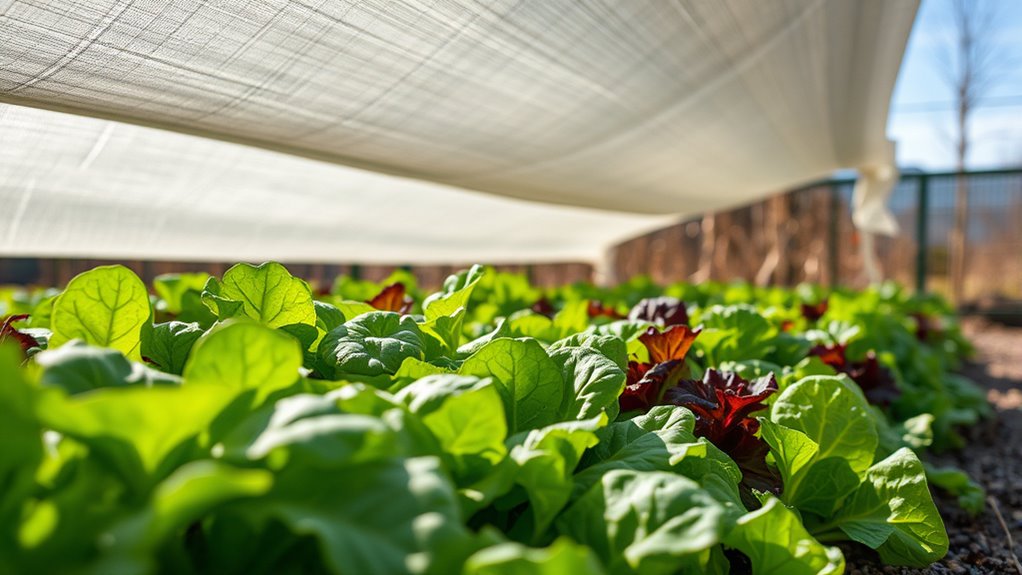
Timing your use of shade cloth is crucial to maximizing its benefits for your salad greens. You should plan around seasonal planting schedules and anticipate weather prediction to determine when shade cloth is most needed. During hot summer months or unexpected heatwaves, deploying shade cloth can prevent bolting and reduce heat stress. In early spring or late fall, using shade cloth helps protect seedlings from intense sunlight that can scorch young plants. Keep an eye on local weather forecasts to identify sudden temperature spikes or prolonged heat periods. By aligning your shade cloth use with seasonal patterns and weather predictions, you ensure your greens stay healthy and productive. Proper timing allows you to extend your salad greens’ growing season and improve overall crop quality.
Maintaining Your Shade Cloth Setup

To guarantee your shade cloth remains effective throughout the season, regular maintenance is essential. Check your setup frequently for wear, tears, or looseness, especially after storms or high winds. Adjust watering schedules as needed, since shade cloth can influence soil moisture levels—consistent watering prevents stress on your greens. Keep an eye out for pests that may hide under the fabric; early detection helps prevent infestations. Consider these maintenance tasks:
- Inspect for tears or damage and repair promptly
- Tighten or reposition the shade cloth as needed
- Adjust watering schedules based on weather conditions
- Monitor for pests and implement pest management strategies
Troubleshooting Common Issues With Shade Cloth Use

If your shade cloth isn’t providing even coverage or your plants aren’t getting enough protection, you might have a coverage problem. You also need to watch for material wear and tear that can weaken the cloth over time. Ensuring proper installation techniques can help you avoid many of these common issues and keep your greens thriving.
Shade Coverage Problems
Shade coverage problems often arise when the cloth isn’t properly installed or adjusted, leading to uneven or insufficient shade for your salad greens. Poor coverage can result in areas receiving too much sunlight, reducing the effectiveness of sunlight reduction. To fix this, check for common issues such as:
- Gaps or sagging in the shade cloth that let sunlight through
- Incorrect tension causing uneven coverage
- Improper attachment points that shift over time
- Inadequate overlap between sections of cloth
Ensuring the cloth is taut, properly secured, and covers the entire area evenly helps optimize shade coverage. Adjusting the tension and re-securing loose sections improves sunlight reduction and prevents hot spots or under-shaded areas. Proper installation guarantees your greens stay healthy longer.
Material Durability Concerns
Since shade cloth is exposed to outdoor elements, its durability can become a concern over time, especially when it faces harsh weather conditions. The fabric’s longevity depends heavily on the quality of its UV resistance, which helps prevent fading, brittleness, and deterioration caused by sun exposure. Cheaper materials often lack strong UV protection, leading to quicker wear and tear. Additionally, constant exposure to wind, rain, and snow can weaken the fibers, causing holes or tears. To maximize lifespan, choose shade cloth with high UV resistance ratings and durable fabric construction. Regular inspections and maintenance can also identify early signs of damage, allowing you to repair or replace sections before the overall fabric integrity is compromised. Proper material selection guarantees your shade cloth remains effective longer.
Proper Installation Techniques
Proper installation is essential to guarantee your shade cloth functions effectively and lasts longer. Ensuring proper material tension prevents sagging and maintains even shade coverage. Use sturdy attachment methods like grommets, tension cables, or bungee cords to secure the cloth tightly. Avoid loose fittings that can cause flapping or damage during wind. When installing, check that the fabric remains taut without overstressing the material, which can lead to tears. Regularly inspect attachment points for wear or looseness and tighten as needed. Consider using eye bolts or hooks to distribute tension evenly. Proper tension and secure attachment methods help prevent issues like sagging, tearing, or wind damage, ensuring your shade cloth provides consistent protection for your salad greens.
Maximizing Growth and Extending Harvest With Shade Cloth
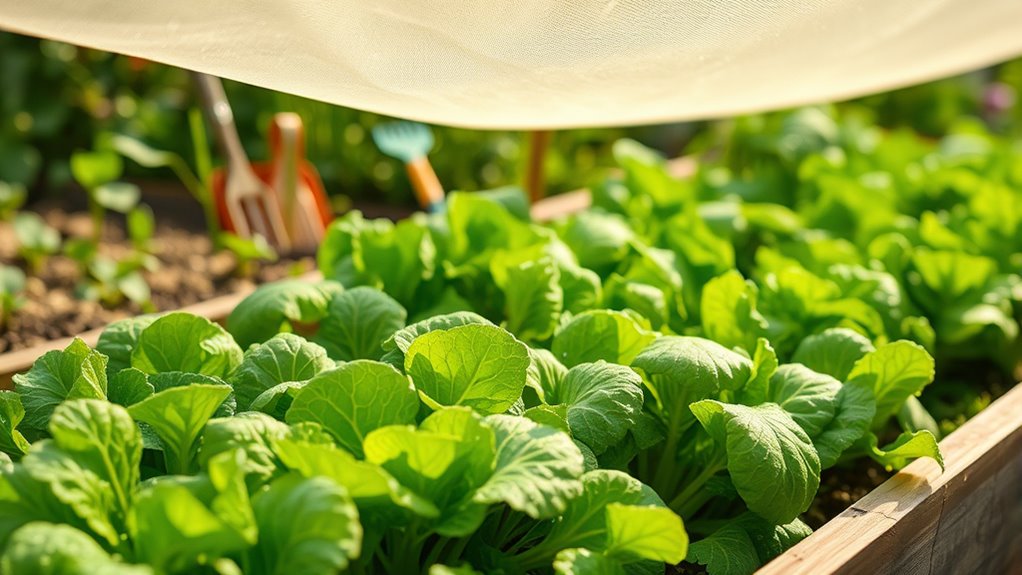
To maximize your salad greens’ growth and extend your harvest, using shade cloth effectively can make a significant difference. Shade cloth helps prevent pests by reducing their ability to reach your plants, minimizing damage and disease. It also promotes water conservation by reducing evaporation, so your greens stay hydrated longer with less watering. By controlling the amount of sunlight, you can keep greens cooler during hot days, encouraging faster growth and preventing bolting. Consistent shade management allows you to harvest over a more extended period, increasing yield. Properly installed shade cloth creates a microclimate that supports healthy development while conserving resources and minimizing pest-related issues, giving you a more productive and sustainable salad greens crop.
Frequently Asked Questions
Can Shade Cloth Prevent Pests From Reaching My Salad Greens?
Shade cloth can act as a pest deterrent by serving as an insect barrier, preventing pests from reaching your salad greens. It creates a physical shield that blocks pests while still allowing airflow and some sunlight. Using shade cloth as an insect barrier helps reduce the need for chemical pest control, keeping your greens healthier. Just confirm the cloth is properly installed to maximize its effectiveness as a pest deterrent.
How Does Shade Cloth Affect Watering Needs for Leafy Greens?
Think of shade cloth as a gentle umbrella shielding your greens from harsh sun. It helps improve watering efficiency by slowing evaporation, so soil moisture stays consistent longer. You’ll find you don’t need to water as often, and your greens drink in just the right amount of moisture. This balance keeps your plants happy and healthy, making watering easier and more effective while protecting your leafy greens from drying out.
Is Shade Cloth Suitable for All Types of Salad Greens?
Shade cloth suitability depends on the salad green variety you’re growing. Some greens, like lettuce and spinach, thrive under partial shade, making shade cloth ideal. However, others like arugula or mesclun may prefer full sun. You should consider the specific needs of each salad green variety to determine if shade cloth is suitable. Adjusting the shade level can help optimize growth and extend your harvest season effectively.
Can I Reuse Shade Cloth Season After Season?
You can reuse shade cloth season after season if you choose a durable material designed for outdoor use. Check the fabric’s material resilience to ensure it withstands weather conditions over time. Reusing saves you money, making it a cost consideration worth noting. Proper storage during the off-season also helps extend its lifespan, so you get the most value from your investment year after year.
What Are the Environmental Impacts of Using Shade Cloth?
When you consider the environmental impacts of using shade cloth, you should think about your carbon footprint and material sustainability. Shade cloth can reduce energy use by protecting plants from extreme heat, but if made from non-biodegradable materials, it may contribute to landfill waste. To minimize impact, choose eco-friendly, durable fabrics that last longer, reducing waste and emissions, and help you promote sustainable gardening practices.
Conclusion
Think of shade cloth as a gentle umbrella for your salad greens, offering them relief from harsh sun and helping them flourish. Just like a skilled gardener tends to delicate plants, you can nurture your greens by understanding their needs. With the right shade and proper care, you’ll extend your harvest and enjoy fresh, vibrant salads longer. Embrace this simple tool, and watch your garden thrive as if under a protective canopy of growth and abundance.

